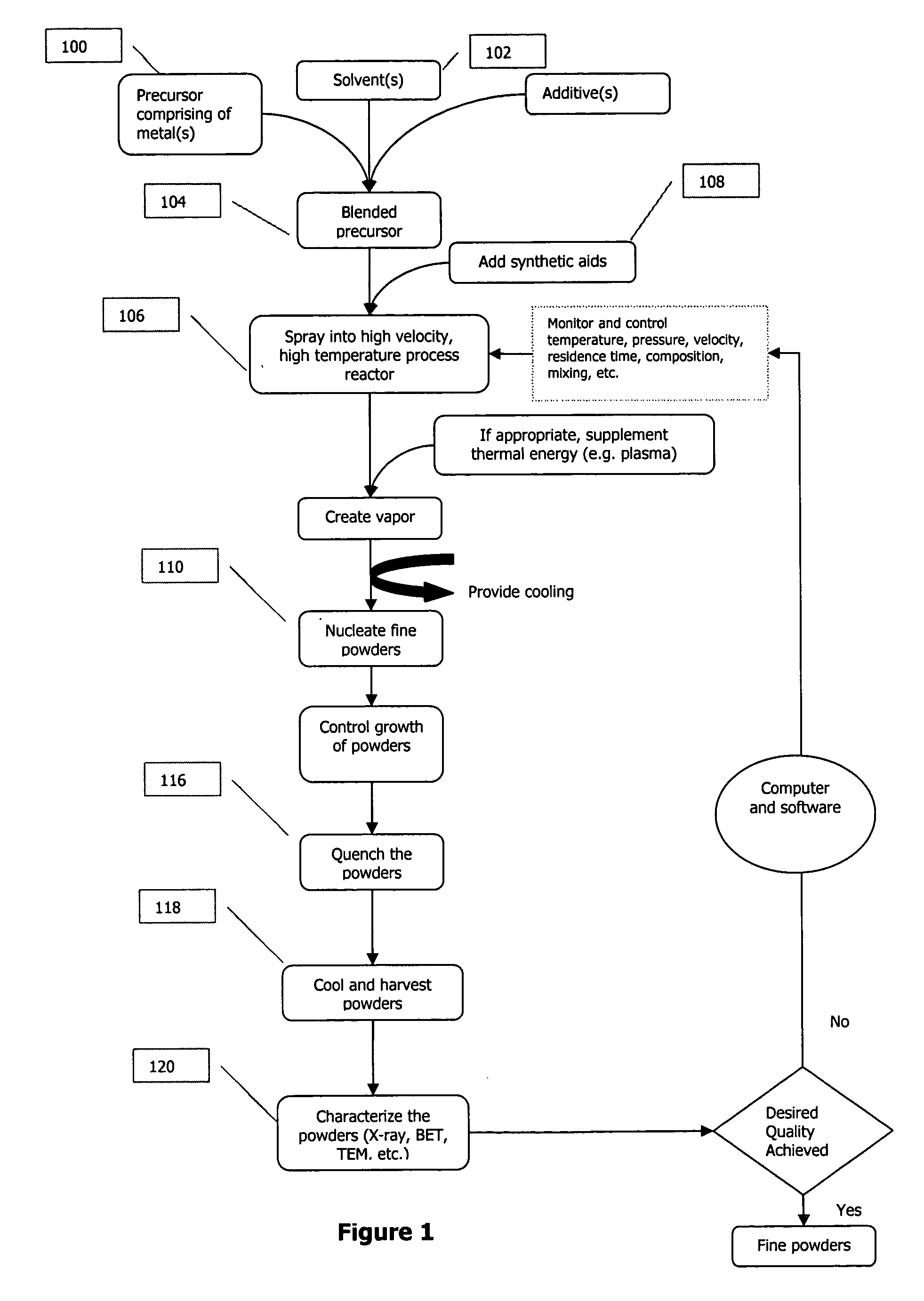Titanium comprising nanoparticles and related nanotechnology
a technology of titanium nanoparticles and nanoparticles, which is applied in the direction of calcium/strontium/barium oxides/hydroxides, alkali metal oxides/hydroxides, and germanium dioxide, etc., to achieve the effect of high volum
- Summary
- Abstract
- Description
- Claims
- Application Information
AI Technical Summary
Benefits of technology
Problems solved by technology
Method used
Image
Examples
example 1
[0112] 99 weight % by metal pure Titanium Tyzor TOT® precursor from DuPont was diluted with 20% by volume hexane from Ashland Chemicals. This mix was sprayed into a DC thermal plasma reactor at a rate of about 80 ml / min using about 145 standard liters per minute oxygen. The peak vapor temperature in the thermal plasma reactor, processed at velocities greater than 0.25 mach, was above 3000 K. The vapor was cooled and then quenched by Joule-Thompson expansion. The powders collected were analyzed using X-ray diffraction (Warren-Averbach analysis) and BET surface area analyzer. It was discovered that the powders had a crystallite size of less than 50 nm, of pure anatase phase, and a specific surface area of greater than 25 m2 / gm. Next, in a separate run with the same process, the mix was sprayed at a rate of about 50 ml / min using about 280 standard liters per minute oxygen. The peak temperature in the thermal plasma reactor was above 3000 K. The vapor was cooled a...
example 2
Rutile Rich Titanium Oxide Powders
[0113] 99 weight % by metal pure Titanium Tyzor NPT® precursor from DuPont was diluted with 20% by volume hexane from Ashland Chemicals. This mix was sprayed into a thermal plasma reactor described above at a rate of about 60 ml / min using about 335 standard liters per minute oxygen. The peak vapor temperature in the thermal plasma reactor, processed at velocities greater than 0.25 mach, was above 3000 K. The vapor was cooled to nucleate and grow the particles and then quenched by Joule-Thompson expansion. The powders collected were analyzed using X-ray diffraction (Warren-Averbach analysis) and BET surface area analyzer. It was discovered that the powders had a crystallite size of less than 40 nm, had rutile to anatase phase in 2:1 ratio, and a specific surface area of greater than 30 m2 / gm.
[0114] Examples 1 and 2 show that nanoparticles comprising titanium can be prepared and that the characteristics of titanium oxide powder can be varied with pr...
examples 3
Barium Strontium Titanium Oxide Powders
[0115] Barium Plastistab® precursor from OM Group, Inc., Strontium 10 HexCem® from OM Group, Inc. and Titanium Tyzor® from DuPont were mixed by weight such that the metal content of Ba:Sr:Ti were in 0.5:0.5:1.0 molar ratios. The mix was diluted with isopropyl alcohol till the viscosity of the precursor was less than 100 cP. This mix was sprayed into a thermal plasma reactor described above at a rate of about 75 ml / min using about 150 standard liters per minute oxygen. The peak vapor temperature in the thermal plasma reactor, processed at velocities greater than 0.25 mach, was above 3000 K. The vapor was cooled and then quenched by Joule-Thompson expansion. The powders collected were analyzed using X-ray diffraction (Warren-Averbach analysis) and BET. It was discovered that the powders had a crystallite size of less than 100 nm and a specific surface area of greater than 20 m2 / gm. The powder matched the expected peaks for barium strontium titan...
PUM
| Property | Measurement | Unit |
|---|---|---|
| temperature | aaaaa | aaaaa |
| crystallite size | aaaaa | aaaaa |
| crystallite size | aaaaa | aaaaa |
Abstract
Description
Claims
Application Information
 Login to View More
Login to View More - R&D
- Intellectual Property
- Life Sciences
- Materials
- Tech Scout
- Unparalleled Data Quality
- Higher Quality Content
- 60% Fewer Hallucinations
Browse by: Latest US Patents, China's latest patents, Technical Efficacy Thesaurus, Application Domain, Technology Topic, Popular Technical Reports.
© 2025 PatSnap. All rights reserved.Legal|Privacy policy|Modern Slavery Act Transparency Statement|Sitemap|About US| Contact US: help@patsnap.com

